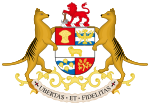Supreme Court of Tasmania
| Supreme Court of Tasmania | |
|---|---|
 |
|

Supreme Court of Tasmania building, Hobart
|
|
| Established | 10 May 1824 |
| Location | Hobart |
| Coordinates | 42°53′10″S 147°19′46″E / 42.886048°S 147.329556°ECoordinates: 42°53′10″S 147°19′46″E / 42.886048°S 147.329556°E |
| Composition method | Vice-regal appointment unpon Premier's nomination, following advice of the Attorney General and the Executive Council. |
| Authorized by | Parliament of Tasmania via the Supreme Court Act 1959 (Tas) |
| Decisions are appealed to | High Court of Australia |
| Decisions are heard for appeals from | Magistrates' Court of Tasmania |
| Judge term length | mandatory retirement by age of 72 |
| Number of positions | 7 |
| Website | www |
| Chief Justice of Tasmania | |
| Currently | Alan Blow OAM |
| Since | 24 April 2008 |
The Supreme Court of Tasmania is the highest State court in the Australian State of Tasmania. In the Australian court hierarchy, the Supreme Court of Tasmania is in the middle level, with both an appellate jurisdiction over lower courts, and decisions made by Court to be heard on appeal by the High Court of Australia.
The ordinary sittings of the Court occur in Hobart, Launceston and Burnie in Tasmania. The Court's Appeal division sits only in Hobart.
The Supreme Court of Van Diemen's Land (as Tasmania was then known) was established by The Royal Letters Patent of 13 October 1823 and commenced activities on 10 May 1824. The Court is the oldest Supreme Court in Australia and predates the Supreme Court of New South Wales, if only by a period of just ten days. Sir John Pedder, after whom Lake Pedder is named, was the first Chief Justice of the court.
The first counsel to appear before the Court was Joseph Tice Gellibrand, who was appointed Tasmania's first Attorney-General, and took his oaths on the first day of the new Court. The first case before the Court was the trial of William Tibbs, who was found guilty and sentenced for manslaughter, receiving 3 years transportation.
It has unlimited jurisdiction within the state in civil matters and hears the most serious criminal matters. It is around the middle of the Australian court hierarchy. The Supreme Court consists of a Trial Division (also known as Original Jurisdiction) and an Appeal Division (or Appellate Jurisdiction).
...
Wikipedia
